Best wines of ProWein 2016
The emotional moments of ProWein—from Champagne to 100-point vintage port!
Happy New Year!
Toasting the New Year with… Bordeaux.
Some nice festive drinking.
It was the sort of event that takes weeks if not months of planning. Browsing internet wine shops, enquiring for offers, searching for tasting notes. Pondering a dinner menu, thinking of food & wine matches. Planning a proper ‘trajectory’ for the event. Alternative scenarios, ‘B’ plans (old bottles are often faulty). In the end I’m happy with how smoothly it went. With some helping hands in the kitchen I managed to serve 12 courses with matching wines to a party of 10, steering clear of major disasters. And it all took short of 9 hours.
I’ll spare you a description of the food – reading about bisques, soufflés and chocolates on a blog always sounds a little over-indulgent and of little usefulness – and share a few tasting notes.
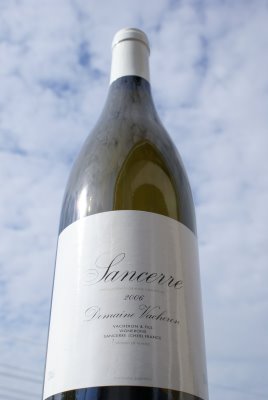
Domaine Vacheron Sancerre 2006
This wasn’t served to guests – it was the cook’s aperitif. It’s quite ripe for a Loire Sauvignon, with subdued acidity but an obvious mineral character. A classy wine, though not a monster of expression. But I prefer Vacheron’s clean style in a less ripe vintage.
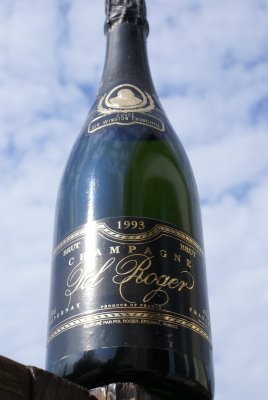
Pol Roger Cuvée Sir Winston Churchill 1993
A gift from the maison that I’ve cellared since 2003. 1993 was a structured vintage, but never great and now largely overshadowed by the likes of 1996. Yet top cuvées from 1993 are now in top shape – this Churchill surely is. Outstanding from the first to the last drop (not that it lasted long). Fresh, unevolved, poised and mineral. There is some underlying sweetness of dosage but also good vinosity and juiciness. The flavour is very fused, and it’s difficult to give a detailed analysis: perhaps a bit of raspberry atop the more usual notes of brioche and vanilla. Still very young – this can go on for another decade or two. Brilliant wine.
We’ve also had some other champagnes including a crisp, engaging Brut Réserve Rosée (two years since dégorgement) from Philipponnat, whom I find very much on the upswing of late.
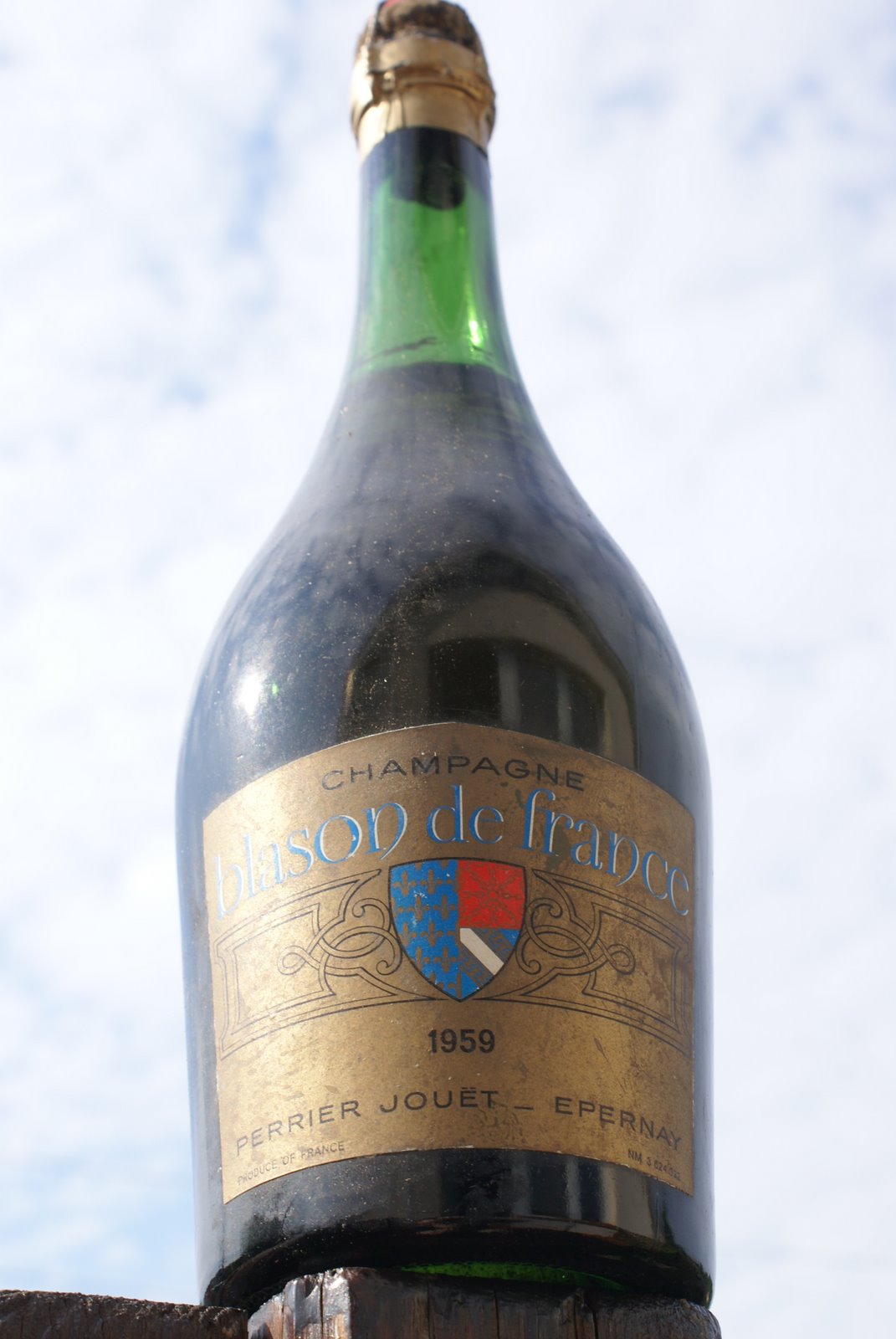
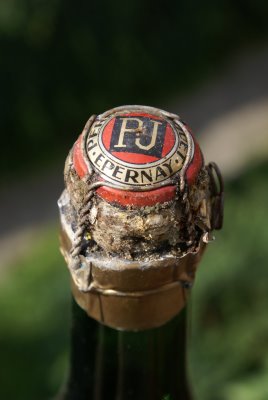
Perrier-Jouët Blason de France 1959
I got this bottle from the Barolo–Brunello shop in Germany. The level was a little low and there was some heavy sediment so I knew the risk (and the very amiable owner Stefan Töpler made it clear). Such old bottles are always a hazard. Here, the cork was completely loose and the wine awfully oxidised with no bubbles. Oh well.
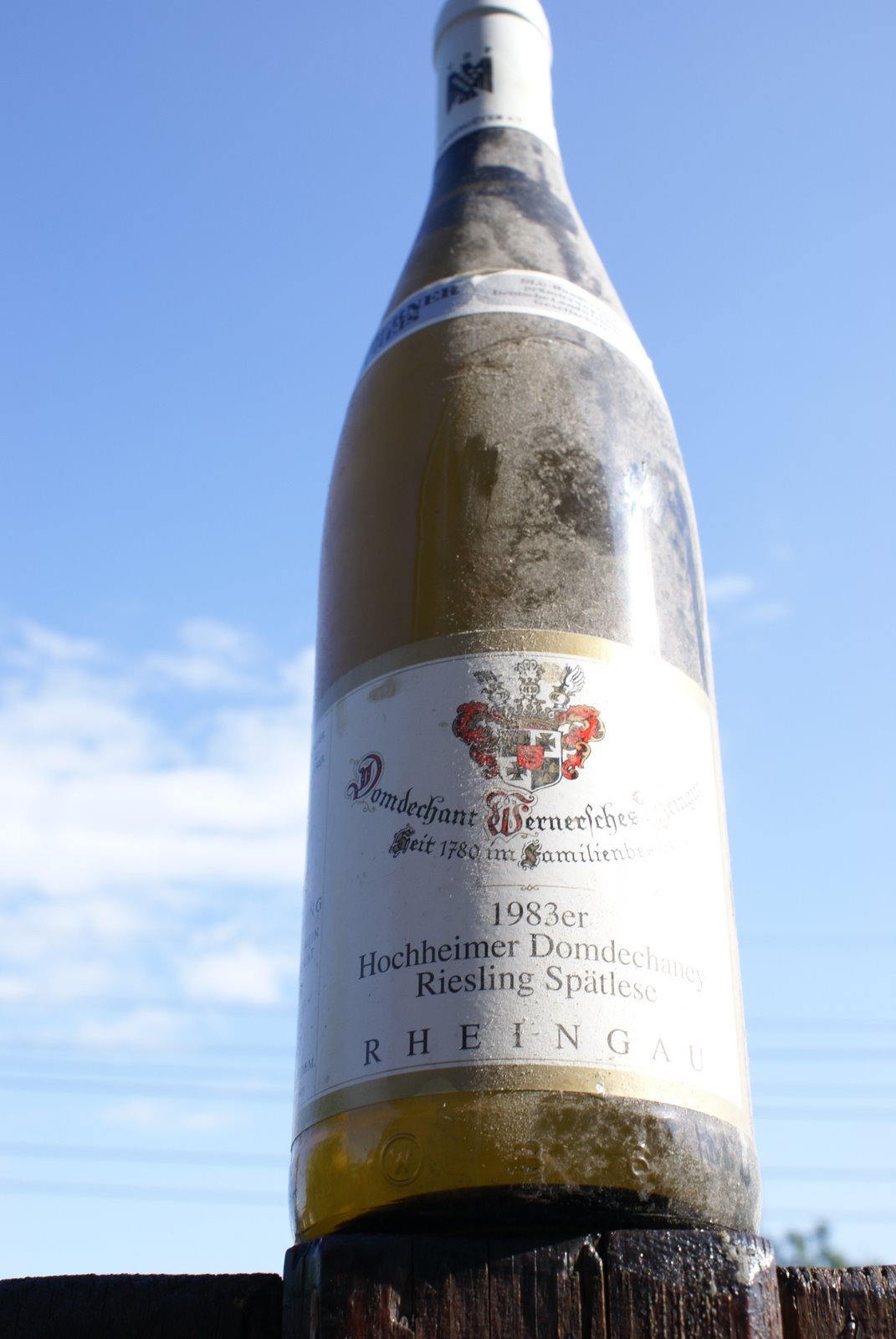
Domdechant Hochheimer Domdechaney
Riesling Spätlese 1983
I visited this estate on the Main near Frankfurt in April 2005, and we’ve had a great conversation with owner Dr. Franz Werner Michel. At lunch, this 1983 was served, and enhanced by Michel’s engaging stories, it tasted as good as any mature Riesling ever did. Upon saying our goodbyes we were offered a bottle each of the same wine. As usually with precious wines, it was waiting in my cellar for an ‘occasion’. A very mature wine, with some storage problems perhaps (cork was completely soaked) showing in a musty, unclean nose, though underneath there is some good Firne [aged Riesling] character. Sweeter than expected on the palate, but there is also a greenness to the sweetness and acidity. This bottle showed a bit unremarkable but was surely short of perfectly stored.
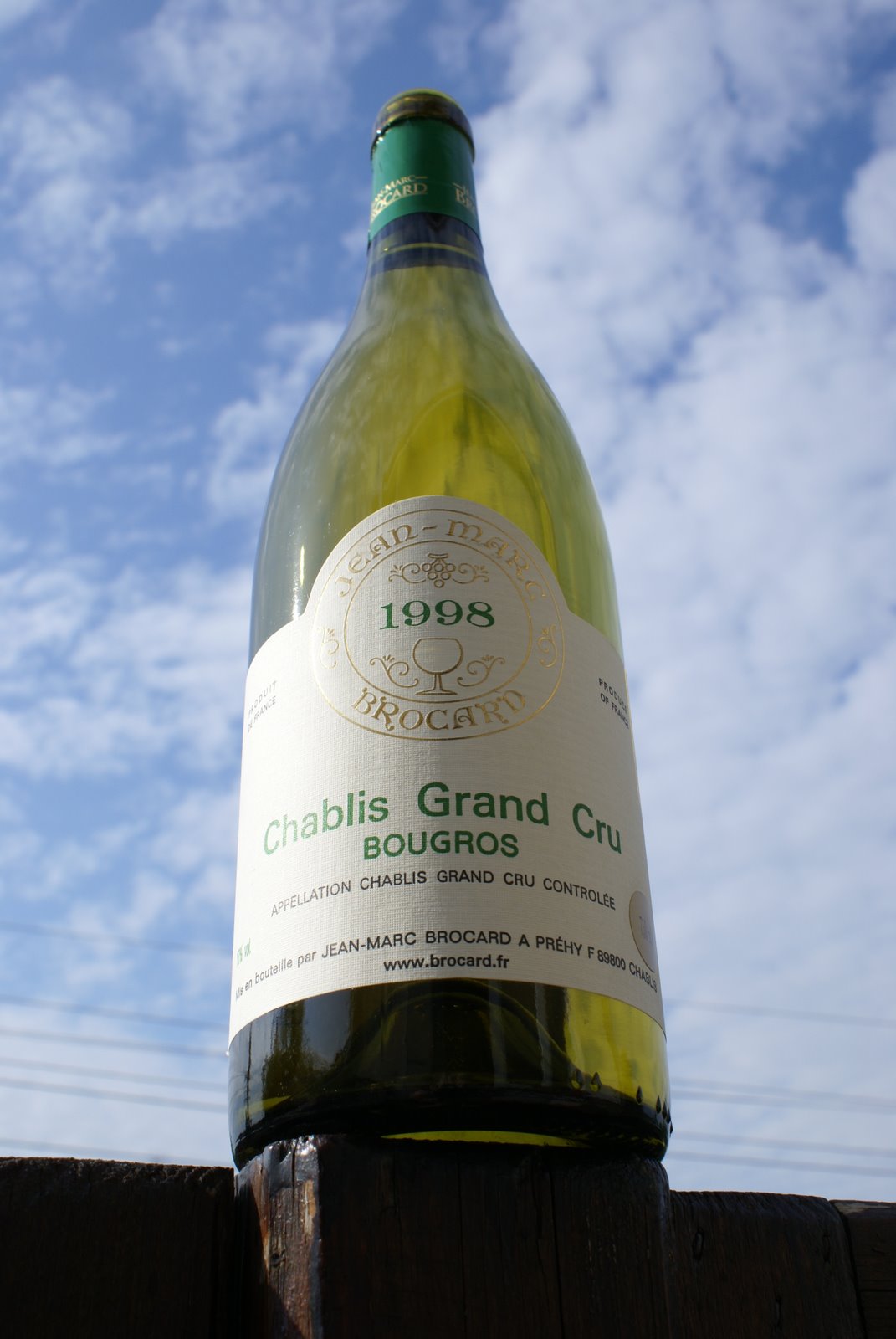
Jean-Marc Brocard
Chablis Grand Cru Bougros 1998
As expected from the youngest wine of the afternoon, no problems whatsoever with this bottle. It was part of a mixed case of older vintages I bought at the estate last October. It’s only 35€ – a bargain for a grand cru of any age, let alone a decade old. When tasted in Chablis, it showed very good saline minerality but also quite some oak sweetness. Yet served with food (a saffron-flavoured poule à la crème), the oak disappeared almost completely. It was a lesson in real-life food & wine matching. Crisp, linear, mineral, statuesque almost, showing power and reserve. An excellent wine. Dregs retasted the day after were less exciting, less poised, built around the butter and vanilla I remembered from October. Not bad at all on a hedonistic level though.
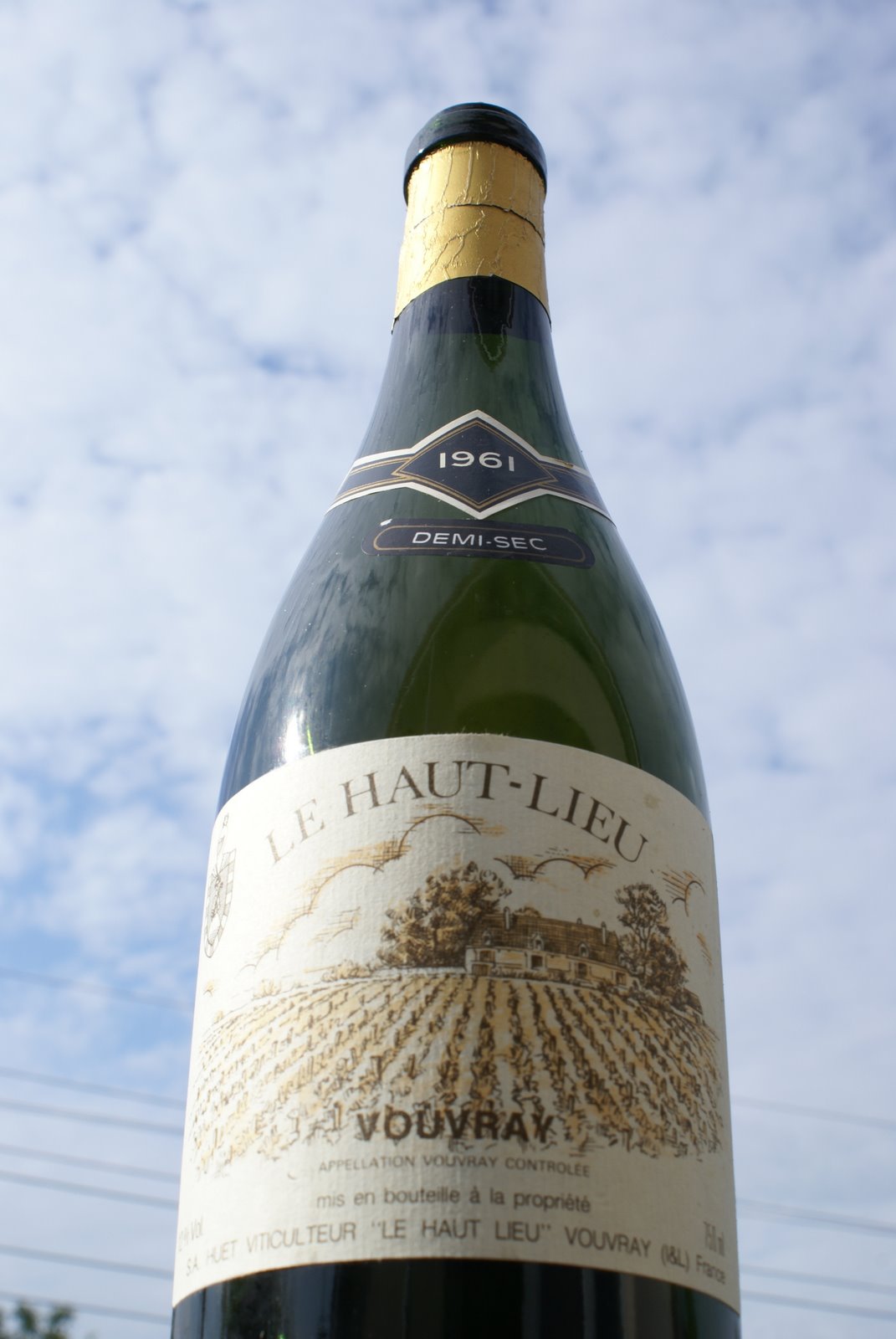
Domaine Huët
Vouvray Le Haut-Lieu demi-sec 1961
I got this bottle a couple of years ago from the excellent Bacchus Vinothek in Germany. The price seemed low (50€), and these Vouvrays are known for their ageing potential so I took the plunge. Looking at the intact label and the immaculate cork it’s clear this bottle was at best recorked (and likely refilled?), and at worst it’s not a 1961 at all. It’s an excellent aged Vouvray but it really tastes too young and dynamic to be 48 years old. The colour is also a bit suspect, with green tinges (unlikely in a wine of this age?) to a medium golden whole:
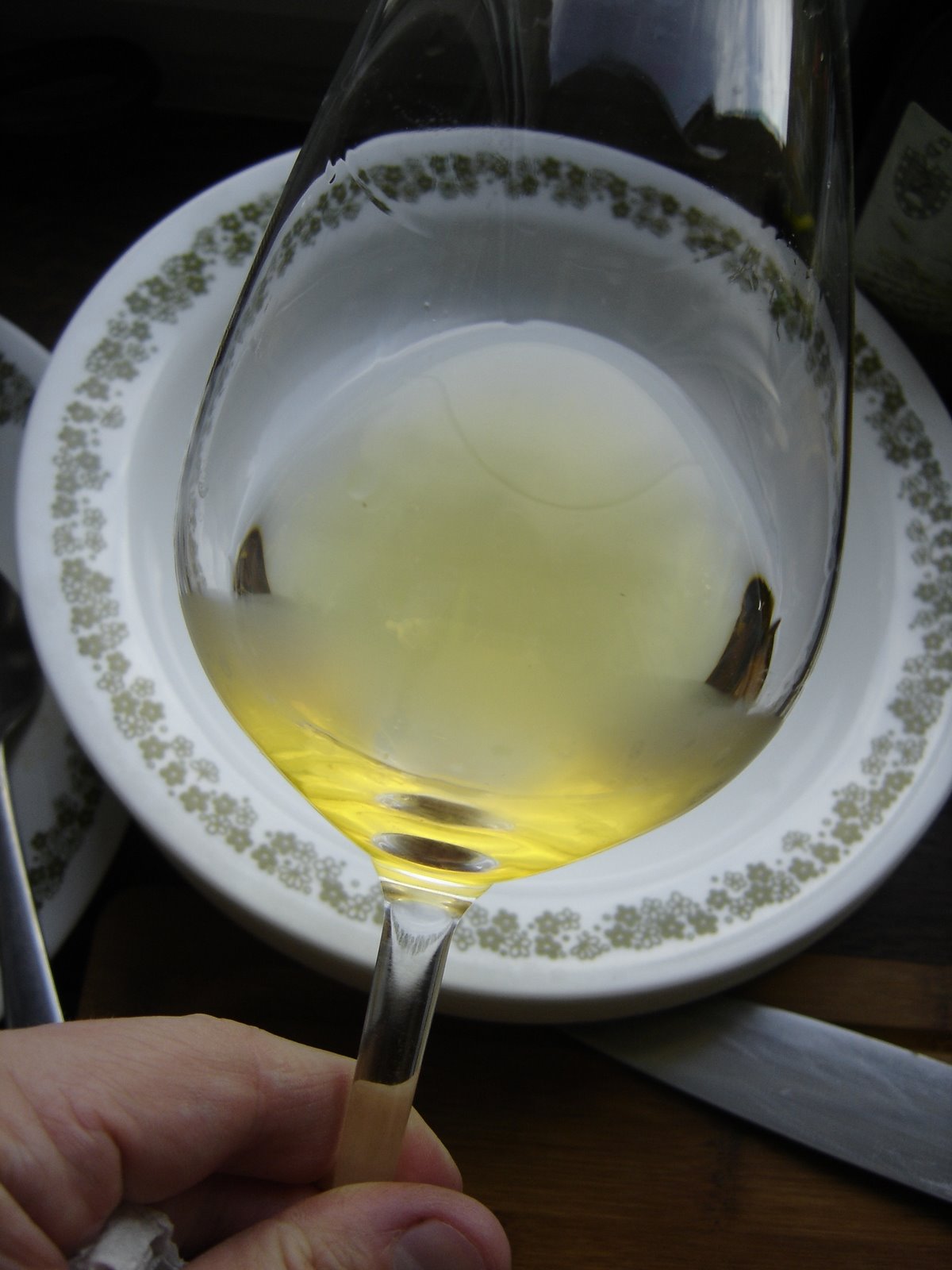
Aromatically it’s dominated by a taut, austere reductive character: not quite stinky but very herby and hayey, with a bit of richness that reminded me of an old Tokaj. On the palate it is very structured with mouth-puckering acidity effectively covering the sweetness, although the demi-sec character is quite pronounced for a wine of this alleged age. There’s also some alcohol (only 12% on the label). A big, structured wine that’s fairly immobile and could easily survive another decade. If you don’t need it to be a genuine 1961 it’s a very fine bottle for the money.
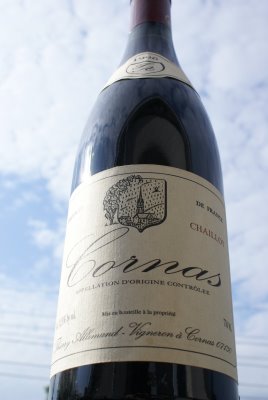
Thierry Allemand Cornas Chaillot 1996
A bin-end from Vienna’s Unger & Klein, sold at 32€ instead of the more usual 60€. Deepish colour especially at core, for the age. It starts fairly barnyardy and reduced on the nose but fortunately isn’t bretty, and with some proper airing this blows off, revealing a fairly engaging nose of crushed raspberries and good vinous depth. Some mild age on the palate but this is far from old. Palate on entry is also pleasant: vaguely varietal and peppery, but the progression is highly disappointing. Basically this just weakens and disappears on the palate. No structure whatsoever: modest acidity (though enough for freshness) and no tannins. There’s a beguiling purity about the whole thing and I can’t say it’s uninteresting but I wouldn’t pay the normal price for it. Perhaps the vintage’s lowly reputation in the northern Rhône is justified after all.
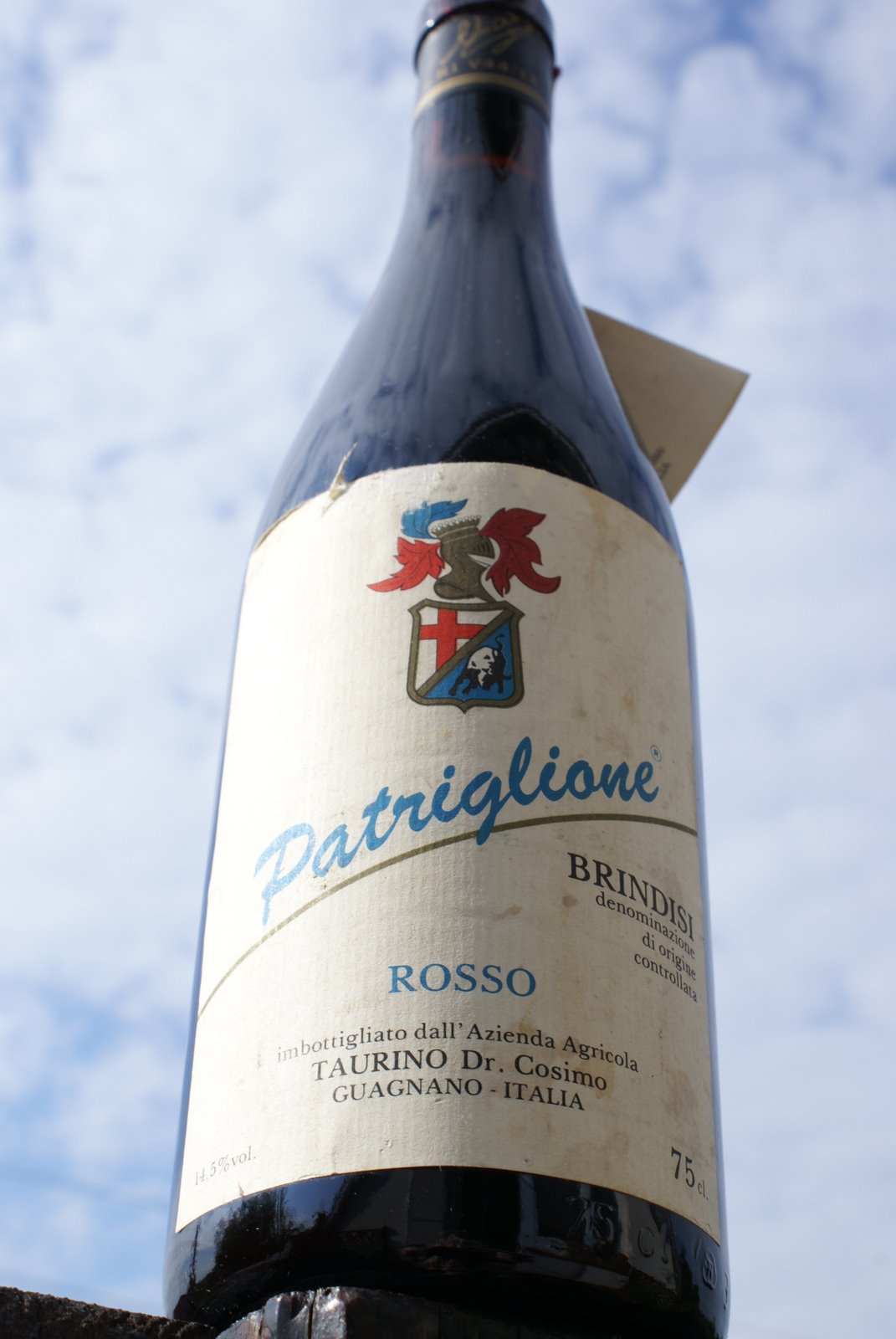
Cosimo Taurino Brindisi Riserva Patriglione 1975
This was another bin-end from a German shop, so obscure they didn’t even know how to price it. Eventually I got away with 35€. In its recent vintages it’s a southern Italian classic I very much enjoy, essentially a modified Salice Salentino (based on the Negroamaro grape) made with an amarone-like technique of drying the grapes to raisins. Fill level is quite and the cork is excellent (certainly recorked) but storage is an issue, as the wine is showing very aged. There’s a leathery, cooked-fruity, vinegary, almost maderised character that some of my diners disliked, though with a bit more experience in Apulian wines I find it fairly typical. This has aged on acidity (and some greenness) but lacks superior dimension or definition. On the other hand a Brindisi red at age 33 in this shape is surely not a bad achievement.
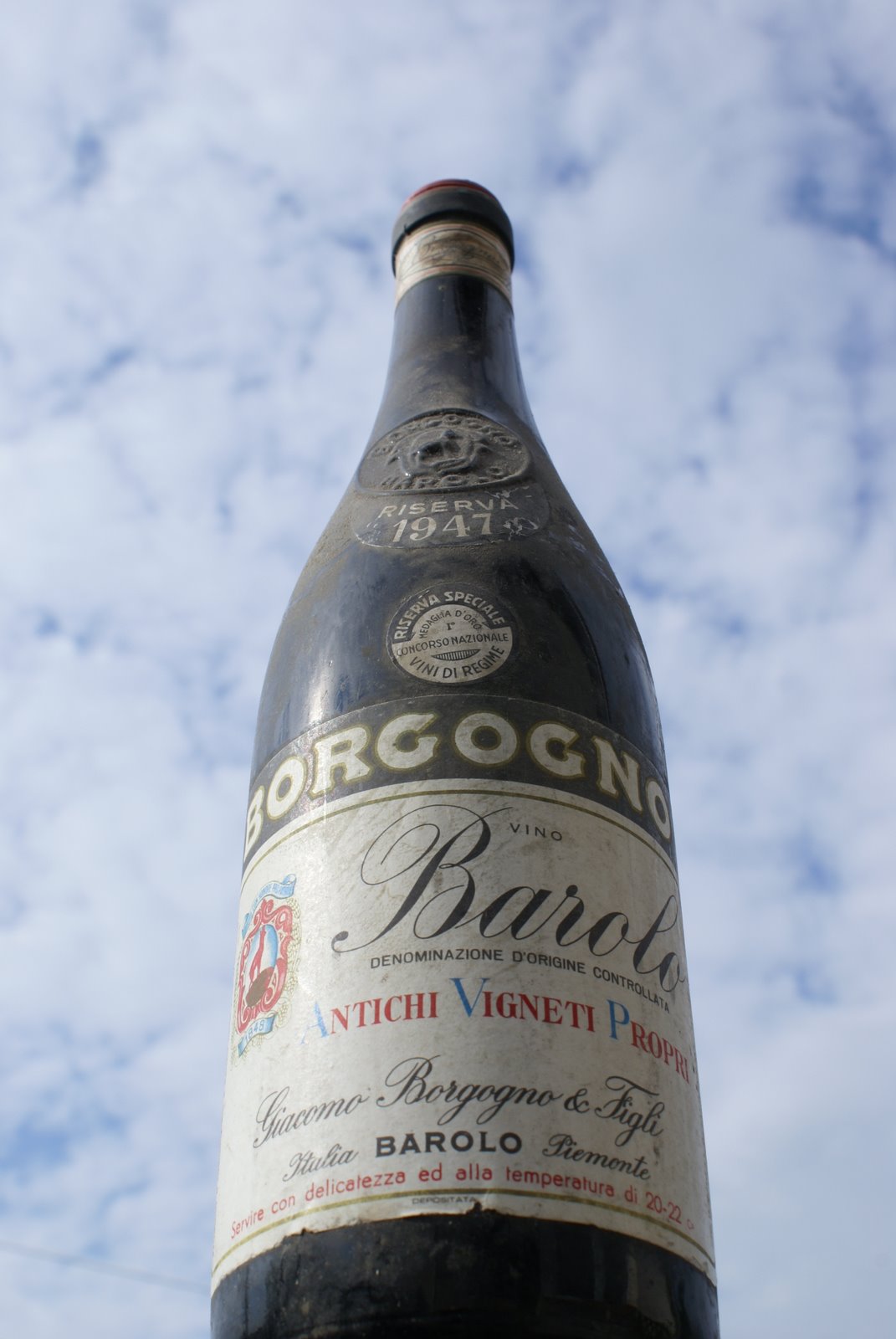
Giacomo Borgogno & Figli Barolo Riserva 1947
It’s another Barolo–Brunello bottle from Stefan Töpler. I paid 149€ for it and whenever I can justify the expense again, I’ll be sure to order some more – an outstanding bottle of wine.
I have had numerous older Barolos from the house of Borgogno, including a fantastically refined 1958, an impressive, brooding 1961 and a gentler 1967. But all came from the producer’s cellar, and were all opened and checked for faults, then refilled with the same wine, recorked and relabelled. Basically you get a Borgogno guarantee that the wine is in good shape. This makes the producer’s prices (the 1961 was 105€ a year ago) even more of a ridiculous bargain.
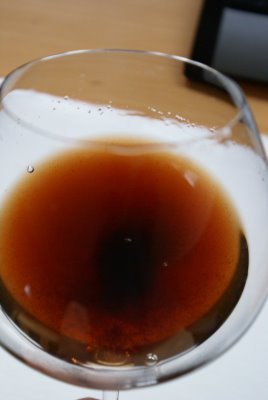 The one disappointing thing here is the nose. I usually enjoy Barolo as much for its fantastically floral, deep bouquet as for anything else, but here it’s a little lifeless, showing modest notes of raspberries, dominated by a green, briney, animal, damp-cellary, mildly over-the-hill character. But palate is very fresh and alive, with beguiling coffeed complexity. Very good length too. Perhaps not the ultimate Barolo experience (1961, with its remaining power, is more impressive) but very interesting for sure. Last sips at room temperature are really tannic (!), mineral, impressively long and so very much alive.
The one disappointing thing here is the nose. I usually enjoy Barolo as much for its fantastically floral, deep bouquet as for anything else, but here it’s a little lifeless, showing modest notes of raspberries, dominated by a green, briney, animal, damp-cellary, mildly over-the-hill character. But palate is very fresh and alive, with beguiling coffeed complexity. Very good length too. Perhaps not the ultimate Barolo experience (1961, with its remaining power, is more impressive) but very interesting for sure. Last sips at room temperature are really tannic (!), mineral, impressively long and so very much alive.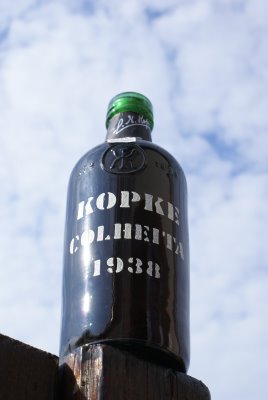 Kopke Porto Colheita 1938
Kopke Porto Colheita 1938It’s a bottle I got as a gift during a trip to the Champagne region in 2003, and liked very much back then. Rich, deep, mineral, terroir-driven, compellingly individual for a champagne, it’s been waiting all these years for a proper ‘occasion’. We all know the feeling. Plenty of bottles too good to drink with casual dinners. But ‘occasions’ are rare and never seem to fit the wines (or vice versa).
That’s why this bottle was opened a little too late perhaps. Nothing wrong: in fact I found its slightly frail stature interesting. It was probably at peak two or three years ago (if not downright in 2003, I fear to say). As often with Champagne, there is enough body and power to sustain the wine even a bit past prime.
So what is it like? It’s predominantly vinous. Vinosity is an important category when understanding and discussing champagne. It’s what really sets the ephemeral featherlight fizz apart from a serious white wine that accidentally has happens to have bubbles in it. There are some gorgeous champagnes that are just champagnes: beautifully crafted and delicious to drink but a little superficial; ‘made’, not ‘born’ as good wine should be (Deutz springs to mind; Gosset also, perhaps). And then there are wines with so much substance and density they really become what champagne essentially is: a northern white Burgundy (many examples, from the better bottles of Bollinger through Jacquesson up to many small growers such as Égly-Ouriet or Larmandier).
This champagne, with its somewhat diminished effervescence, is tasting like a mature Meursault. Honey, butterscotch, brioche, praline, some elusive hazelnut, underpinned by a vestige of peary fruit. Then silence, and later, a tight core of minerality. The east-facing bare limestone slopes of Avize shine on the finish. This wine is sensually delicious – it’s Chardonnay at its most Baroque, with sweetness aplenty – but it is also very transparent and terroir-truthful. And that’s quite an achievement for champagne.
Agrapart is a house well-known to aficionados but surely less so to the general public. I see from recent reviews that they’re doing well. The wine I am drinking today is now called Avizoise. I’m sure the good recent vintages – such as 2002 – would be a very fine choice for cellaring. Save it for a big occasion.
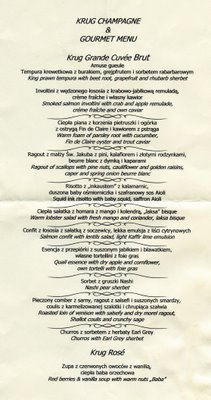 A taster’s treat tonight. A Krug champagne dinner cooked by Poland’s best chef, Paweł Oszczyk at the Régina hotel in Warsaw. Nominally this dinner was for the launch of the Krug Rosé in Poland, although we drank the Grande Cuvée Brut for most of the evening (and started, atypically, with a most pleasant glass of Cloudy Bay Sauvignon Blanc 2007; Cloudy Bay and Krug belong to the world’s most glamorous brand conglomerate, Louis Vuitton Moët Hennessy).
A taster’s treat tonight. A Krug champagne dinner cooked by Poland’s best chef, Paweł Oszczyk at the Régina hotel in Warsaw. Nominally this dinner was for the launch of the Krug Rosé in Poland, although we drank the Grande Cuvée Brut for most of the evening (and started, atypically, with a most pleasant glass of Cloudy Bay Sauvignon Blanc 2007; Cloudy Bay and Krug belong to the world’s most glamorous brand conglomerate, Louis Vuitton Moët Hennessy).
As improbable as it sounds, it was hard work. No fewer than 12 courses were served, and I tried to evaluate the wine & food match each time. Some of the highlights were a scallop ragoût where a mild note of burnt butter paired very well with Krug’s long-aged richness, a fantastic discovery with a side dish of gingered al dente lentils, and a stunningly savoury dish of apple-flavoured quail broth with a single tortellino on top (this proved perhaps a bit too gamey for the champagne).
There were also a few duds, such as a prawn tempura with fresh grapefruit that didn’t match at all, and a very well-cooked rack of venison with caramelised shallots which cried for the Krug Rosé – but the latter was only served with dessert. It was a night of excess, and 11 courses paired with a single wine was really too much – there was no way to keep the diners’ attention sharp throughout the menu.
The wines? The Krug Rosé is well-tailored wine with good structure and discrete pink fruit, but it is really nothing special against other rosé champagnes, and costs the earth. The Krug Grande Cuvée was its usual rich, complex, potent self. We actually tasted a range of various disgorgement dates (i.e., wines that had a different time in the cellar after the post-fermentative yeast deposit was removed; sounds geeky but it is a crucial factor for the taste of a champagne). Contrarily to expectations, the younger bottles were showing richer, really quite oaky, with a lot of what the French call charpente – I preferred them over the older bottles that were quite acidic. I probably drank more Krug tonight than I will for the remainder of my life.
For almost seven years now, I have almost exclusively been tasting in just one kind of glass. The One For All Magnum, designed by
Peter Steger and distributed by Schott Zwiesel. I first tested this glass at the Mondavi stand (don’t quote me) at the ProWein fair in Germany, and was immediately hooked. Later I had the chance of comparing it with 30 other models in a blind (in fact, literally blind-folded) tasting for the Polish WINO Magazine. It came out my 1st choice for red wine and 2nd for white. Since then, I tasted thousands of wines from this glass, white, red, rosé, sparkling, sweet, fortified, and even used it on the rare occasions I taste spirits. It was the only glass I used at home, and I carried it on all my wine travels from Lisbon to Georgia. (There was the notable exception of Gianfranco Soldera in Montalcino who forbade me entering his cellar with this glass).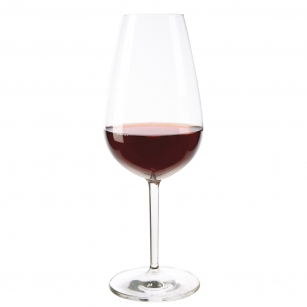 Why this glass? In short, it is a fantastic all-rounder. It works well with a wide range of wine styles from the lightest Riesling Kabinett to full-bodied red wines like Bordeaux, Brunello etc. It is a brilliant analytic tool: its narrow chimney-like rim concentrates and focuses aromas. (For this reason, I am less enthusiastic about using it as a table glass, when wines are meant to accompany food and conversation rather than delivering flashy 10-second presentations). The difference in aromatic intensity of the same wine tasted from this glass and a standard large Bordeaux model is stunning. Often at panel tastings, I can elaborate freely on a given wine’s bouquet while my colleagues who are using standard Bordeaux bowls only get a vague red-winey profile. Importantly for me, this glass is also very resistant (no comparison with fancy models from more famous glassmakers; while my breakage rate of R*** glasses was close to 5 per week, it really takes a heavy fall to destroy the One For All) and also rather inexpensive: it costs me around 4 € apiece here in Poland.
Why this glass? In short, it is a fantastic all-rounder. It works well with a wide range of wine styles from the lightest Riesling Kabinett to full-bodied red wines like Bordeaux, Brunello etc. It is a brilliant analytic tool: its narrow chimney-like rim concentrates and focuses aromas. (For this reason, I am less enthusiastic about using it as a table glass, when wines are meant to accompany food and conversation rather than delivering flashy 10-second presentations). The difference in aromatic intensity of the same wine tasted from this glass and a standard large Bordeaux model is stunning. Often at panel tastings, I can elaborate freely on a given wine’s bouquet while my colleagues who are using standard Bordeaux bowls only get a vague red-winey profile. Importantly for me, this glass is also very resistant (no comparison with fancy models from more famous glassmakers; while my breakage rate of R*** glasses was close to 5 per week, it really takes a heavy fall to destroy the One For All) and also rather inexpensive: it costs me around 4 € apiece here in Poland.
But this glass has a serious shortage. There is one type of wine it doesn’t really work well with: lighter-coloured, high-acidity, aromatic reds. Basically this is not a good Pinot Noir glass. And while I drink almost no Burgundy at home and wouldn’t really bother, it also does no favour to a grape I cherish: Nebbiolo. Since well around 50% of my ‘festive’ drinking is Barolo or Barbaresco, I finally decided it was time to get a box of dedicated Nebbiolo glasses.
So I phoned the local distributor of Schott-Zwiesel (I decided to stick to this glassmaker because of the extra resistance of their patented glass, and the affordable price), and asked to try several of their Pinot Noir models with a glass of Barbaresco (in this case, I opened a Giuseppe Cortese Rabajà 2001, a wine I know well). Here is a short summary of my impressions:
Top Ten #125
Fruity and mineral, overall this is showing vastly more Nebbiolo-typical than the Cru 140. Less alcohol, although wine seeming perhaps more mature / integrated. Palate along the lines of the nose with some evolution, a rounder, peppery expression, less inert than the Cru Classic above. Really changing in time (even though the airing surface doesn’t seem so huge). A nice compromise between the two below glasses but I can’t resist an impression of alcohol and bake.
Enoteca #150
Lovely nose, remarkable elegance. A little greenness. Rather integrated but less advanced than the Top Ten above. On the palate this glass tends to simplify a bit, no rough edges here but a little short? Very good freshness, the cleanest taste of all 4 glasses. Later picks up more length and the wine becomes more complete.
One For All Magnum
I brought this one to compare the new glasses with one I know well. On the nose this gives the wine good freshness and directness of expression, but diminishes the complexity. Seems a little coarse (alcohol is a bit emphasised). A good choice when this is your standard, although clearly a little at odds with this wine style. Tasting simplest and least typical of the 4 glasses, this makes the rather traditional Cortese taste like a modern barrique-aged Nebbiolo! While on the nose this glass makes a statement, the palate is quite underwhelming: an impression of lower acidity brings a duller, as if suffocated expression.
I ended up ordering 6 pcs. of the Enoteca 150. Several bottles of Barolo opened since Christmas have confirmed this was an excellent choice. This glass is particularly adapted to the more complex bouquets of older (10+ years) traditional-aged Nebbiolo.
On the same occasion, I also experimented with some glasses for Champagne and spirits. For those interested, my tastings notes appear below:
Champagne glass comparison with Deutz Brut Classic :
Top Ten #77
Apple and yeastiness on nose, with good emphasis on minerality. Best nose together with One For All below. Palate is a little dressed up but well assembled between elements. Nuttier, more complete than the Fine 77. Interesting how well this integrates (at the same time slightly emphasising) residual sugar. Longer lived bubbles here. Best of 4.
Fine #77
Sweeter, headier, plus the narrow rim is a little fastidious. Wine becomes less aromatic, analytic, chalky. Impression on palate is better, with more softness and elegance, less hard and dry than above. Surely fuller than the Fine 155 below. Not too long.
Fine #155
Unexciting, this is closing the wine instead of allowing it to open. A chewy palate is not bad but simple. Wine stays dry but fruity. Medium+ length. Worst of 4.
Spirits comparison with:
Marolo Grappa Dedicata al Padre (60% no less)
Bowmore 15 y.o. Single Malt Whisky ‘Mariner’
 Enoteca #155
Enoteca #155
Grappa: Sweet, noble, grapey, really fruity, only end of nose is a little vegetal. Alcohol seems really attenuated. Compared to the similarly shaped Top Ten this smells a little more chemical.
Whisky: Mostly peaty, saline, really unalcoholic, soft, elegant, very good. This is giving this whisky’s lightest and whitest expression, also on palate. Very interesting.
Top Ten #155
Grappa: Less fruity than Enoteca, and alcohol is felt. But let rest and sum of elements seems more than Enoteca which is a little too grapey. Always a certain appley sweetness here. Despite a certain sweaty warmth this is the best impression. Tastewise this is also making a big impression with an explosion of flavour.
Whisky: More opaque than the Enoteca. Far less intense and precise. Taste is not bad with some more oaky honey and decent length but I think worst of 4 with this whisky.
 Fine #155
Fine #155Comments: the One For All is hardly a typical spirit glass, yet is has some obvious advantages over the smaller models: bouquets are far more intense and complex. A tricky glass with cask strength spirits, it is really a discovery with the whisky. As for the latter, normally with wood-aged spirits you are supposed to use a different, more open shape than with white spirits, but my consumption of both being marginal, it only makes sense for me to have one glass for both styles, hence my decision to taste whisky in these.